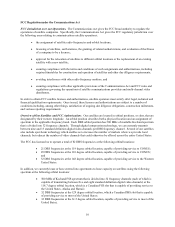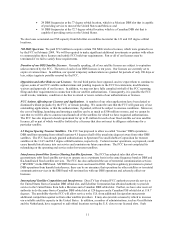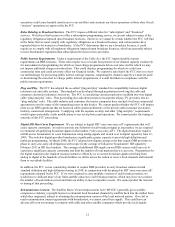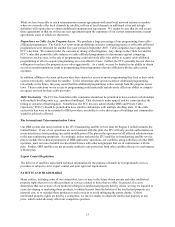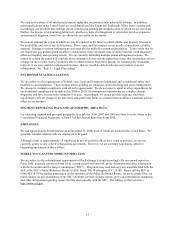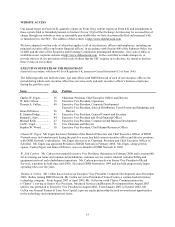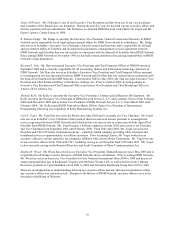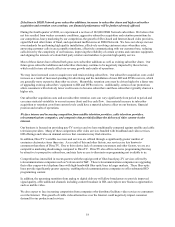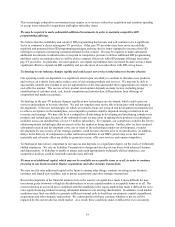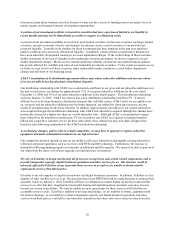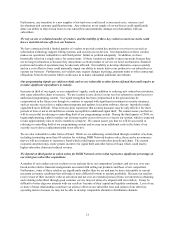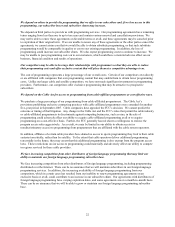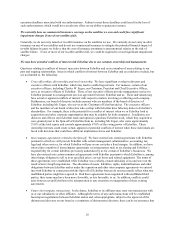Dish Network 2008 Annual Report Download - page 30
Download and view the complete annual report
Please find page 30 of the 2008 Dish Network annual report below. You can navigate through the pages in the report by either clicking on the pages listed below, or by using the keyword search tool below to find specific information within the annual report.
20
forecast and plan future business activities because we may not have access to funding sources necessary for us to
pursue organic and strategic business development opportunities.
A portion of our investment portfolio is invested in securities that have experienced limited or no liquidity in
recent months and may not be immediately accessible to support our financing needs.
A portion of our investment portfolio is invested in asset backed securities, auction rate securities, mortgage backed
securities, special investment vehicles, and strategic investments and as a result a portion of our portfolio has
restricted liquidity. Liquidity in the markets for these investments has been impaired in the past year and these
market conditions have adversely affected our liquidity. In addition, certain of these securities have defaulted or
have been materially downgraded causing us to record impairment charges. If the credit ratings of these securities
further deteriorate or the lack of liquidity in the marketplace becomes prolonged, we may be required to record
further impairment charges. Moreover, the current significant volatility of domestic and global financial markets
has greatly affected the volatility and value of our marketable investment securities. To the extent we require access
to funds, we may need to sell these securities under unfavorable market conditions, record further impairment
charges and fall short of our financing needs.
AT&T’s termination of its distribution agreement with us may reduce subscriber additions and increase churn
if we are not able to develop alternative distribution channels.
Our distribution relationship with AT&T was a substantial contributor to our gross and net subscriber additions over
the past several years, accounting for approximately 17% of our gross subscriber additions for the year ended
December 31, 2008 and 19% of our gross subscriber additions in the fourth quarter. This distribution relationship
ended on January 31, 2009. AT&T has entered into a new distribution relationship with DirecTV. It may be
difficult for us to develop alternative distribution channels that will fully replace AT&T and if we are unable to do
so, our gross and net subscriber additions may be further impaired, our subscriber churn may increase, and our
results of operations may be adversely affected. In addition, approximately one million of our current subscribers
were acquired through our distribution relationship with AT&T and subscribers acquired through this channel have
historically churned at a higher rate than our overall subscriber base. Although AT&T is not permitted to target
these subscribers for transition to another pay-TV service and we and AT&T are required to maintain bundled
billing and cooperative customer service for these subscribers, these subscribers may still churn at higher than
historical rates following termination of the AT&T distribution relationship.
As technology changes, and in order to remain competitive, we may have to upgrade or replace subscriber
equipment and make substantial investments in our infrastructure.
Our competitive position depends in part on our ability to offer new subscribers and upgrade existing subscribers
with more advanced equipment, such as receivers with DVR and HD technology. Furthermore, the increase in
demand for HD programming requires investments in additional satellite capacity. We may not be able to pass on to
our subscribers the entire cost of these upgrades and infrastructure investments.
We rely on EchoStar to design and develop all of our new set-top boxes and certain related components, and to
provide transponder capacity, digital broadcast operations and other services for us. Our business would be
adversely affected if EchoStar ceases to provide these services to us and we are unable to obtain suitable
replacement services from third parties.
EchoStar is our sole supplier of digital set-top boxes and digital broadcast operations. In addition, EchoStar is a key
supplier of other satellite services to us. Because purchases from DISH Network are made pursuant to contracts that
generally expire on January 1, 2010, EchoStar will have no obligation to supply digital set-top boxes and satellite
services to us after that date. Equipment, transponder leasing and digital broadcast operation costs may increase
beyond our current expectations. We may be unable to renew agreements for these services with EchoStar on
acceptable terms or at all. EchoStar’s inability to develop and produce, or our inability to obtain, equipment with
the latest technology, or our inability to obtain transponder capacity and digital broadcast operations and other
services from third parties, could affect our subscriber acquisition and churn and cause related revenue to decline.


